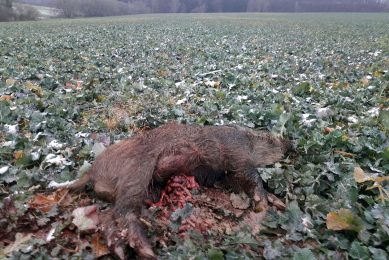Preventing 5 major pig diseases in a breeding herd
![When sows have been protected well, their offspring have fewer challenges to fight. [Photo: Bart Nijs]](https://www.pigprogress.net/app/uploads/2021/04/001_416_rb-image-2693013-848x565.jpeg)
How to prevent 5 major pig diseases from ?occurring? The key to the answer often lies in the breeding herd. After all, negative sows breed ?negative piglets. In order to eradicate pathogens from the breeding herd, vaccines and especially ?antibiotics play a pivotal role.
As a veterinarian, prevention of infections is a subject that is very close to my heart. Any article on dealing with pathogens and how to prevent them should touch on some basic rules that can avoid a lot of trouble.
Starting with high health is the best place to be. Get reports of the health of breeding herds before purchasing stock. Get your vet to talk to their vet. Check the reliability of the breeding company from a disease perspective, not just on the genetic potential. If it brings disease on to the farm, it can blow away any of the genetic potential improvements you were hoping for. I have recently seen this with a hyper-prolific breeding herd but it spread Streptococcus suis as well.
Don’t merge farms. I am a great believer in closed herds, if possible; it stabilises immunity and reduces the risk of disease introduction. Every time new animals (gilts mainly) are brought on to the farm there is a risk of disease introduction and also they have to acclimatise to what infections are present. Importing semen is usually the safest option for limiting disease risk, whilst still being able to improve the herd’s genetics. There have been recent occasions where boar studs have broken down with Porcine Reproductive and Respiratory Syndrome virus (PRRSv), so nothing is totally risk free. Purchasing of pigs for finishing is always potentially high risk.
Biosecurity is still the most important way of keeping disease out. It is critical for staying disease free or maintaining your current health status and must be a part of any eradication programme; otherwise the chances of long-term success are severely limited. On many farm visits, one finds biosecurity is minimal and surprisingly, when you ask “how did the disease come in?” the farmer knows but has not really done anything to stop further infections coming in – too much trouble? Or if they have carried out eradication before they expect it to break down within 6-12 months “like it did the last time.” I frequently say “think of the farm as a fortress and how best you can defend it and keep infections outside.”
More specific pathogens and prevention
If we look at prevention of disease we have been fortunate to have usually an array of vaccines, therapeutic drugs etc to control the effects of the disease. Improvements in management, housing, heating and ventilation, nutrition all have played a part. It is when we have got one infection, then another, then another, the effects of disease complexes can make a major impact on a farm’s productivity and profitability and then the farmer usually considers the eradication option.
A combination of PRRSv, which is immunosuppressive, Enzootic Pneumonia (EP), which can also be immunosuppressive and a pathogenic strain of Actinobacillus pleuropneumoniae (App), leading to the porcine respiratory disease complex (PRDC) is a classic example. If the App isolate has developed resistance to the cheaper antibiotics like tetracyclines or trimethoprim/sulphas it is almost a necessity to go for the eradication option. Breaking down with swine dysentery is also a common reason to go for eradication because of its severity.
Most eradication programmes are focused on eliminating infections from the breeding herd. There they usually have some immunity, a low level shedding of the virus or bacteria and a good chance of getting rid of the bug. Trying to eradicate infections from growing pigs is very difficult and also costly, so partial depopulation of the growing/finishing herd is important.

Porcine Reproductive and Respiratory Syndrome virus (PRRSv)
The European strain is generally considered mild in comparison with the US strains, hence the conundrum is: Is it worth eradicating, do we just live with it, or shall we just vaccinate?
PRRSv is a RNA virus and tends to change quite rapidly. There appears to be a lot of sub-strains and when the farmer, his vet and I were considering eradication we were concerned that the current vaccines may not be effective or sufficiently immuno-stimulating to eliminate the infection from the breeding herd. In the recent trials we carried out, we found a combination of the live PRRS vaccine (Porcilis PRRS – MSD Animal Health) and the killed vaccine (Ingelvac PRRS KV – Boehringer Ingelheim) worked very well. The whole breeding herd was closed including an extra stock of gilts and all were vaccinated at the same time, first with the killed vaccine and then at monthly intervals with the live vaccine, which had been used routinely in the sows for prevention.
Piglets were monitored for circulating virus by PCR after the three sow vaccinations and appeared negative by two months. Finishing pigs coming through the repopulated finishing site have remained negative over the last 18 months. Biosecurity was also introduced, so that no vehicles came directly on site, there was a changing room built, so that all visitors had to change into farm overalls, boots and wash their hands before entering the farm.

Enzootic pneumonia (Mycoplasma hyopneumoniae)
Eradication of M. hyopneumoniae has been a task since its discovery. Commercial eradication programmes developed by basically medicating the breeding herd with antibiotics to eliminate the infection from already immune animals. This has worked incredibly well with almost an 80-90% success rate. Tiamulin (Denagard – Elanco) has proven highly effective as have the tetracyclines on their own or in combination with tiamulin. The macrolide tilmicosin (Pulmotil – Elanco) is also considered highly effective and has the potential to eliminate some bacterial infections such as A. pleuropneumoniae and occasionally S. suis. Tylvalosin (Aivlosin – Eco Animal Health) in feed, coupled with injections of tulathromycin (Draxxin – Zoetis) have also been successful for EP.
The breeding herd must be closed during the treatment period and the young stock sent off site, so there is no chance of reinfection. Originally, medication was given for only two weeks as the organism does not survive outside the host that well. More recently, to ensure all the sows get the correct dose for a sufficient length of time, I have extended it to three to four weeks. Dry sows eat about 1% of their bodyweight (2.5 kg food/250 kg bodyweight) so for tiamulin alone we have used 10 mg/kg bodyweight and this requires 1000 ppm of drug to be included in the feed. Lactating sows can take in more food usually 2-2.5% bodyweight so the inclusion rate can be reduced accordingly to 400-500 ppm but it needs to be calculated. The problem is the sows that go into the farrowing house five days before farrowing and around farrowing time, their feeding may be restricted or they may not have much appetite around farrowing. So for these sows they are almost missing out on a week’s medication, so to make sure, the medication period was extended. Also, if tiamulin was being used for swine dysentery or Brachyspira hyodysenteriae eradication at the same time, it was advisable to use four weeks high medication followed by four weeks medium medication, to ensure there was time to clean and disinfect the farm and allow the organism to die out in the environment.

Pleuropneumonia (Actinobacillus pleuropneumoniae)
There are a number of different serotypes of App (approximately 15) of different pathogenicity.
Eradication programmes mainly involved the use of tilmicosin in feed. Especially, in the early days of PRRSv infection plus EP and APP, the use of tilmicosin was advocated ‘to clean up’ the herd. High levels of medication (15 mg/kg bodyweight or 1500 ppm in dry sows) were used for two weeks. They cleared out the EP (reportedly 80-90%) but only had a 50% effect on App eradication. Generally, the pig’s performance improved for about a year before breakdown. The biosecurity of the farms was not always reported. It is essential to carry out antimicrobial sensitivity tests before embarking on an App procedure. Some laboratories use other macrolides, like tylosin or erythromycin, to test for tilmicosin resistance, so can be confusing as tylosin is much less active. Sixteen µg/ml is the MIC breakpoint for tilmicosin.
Recently, we used marbofloxacin by injection with the long-acting formulation (Forcyl – Vetoquinol) in the breeding herd with an excellent response, although it was quite costly.

Swine dysentery (Brachyspira hyodysenteriae)
Swine dysentery is one of the diseases that I recommend eradication, if possible, rather than trying to live with it. The pleuromutilins, tiamulin and valnemulin (Econor – Elanco) are probably still the most effective, followed by lincomycin (Lincocin – Zoetis) and tylvalosin, but recently tylosin, another macrolide, lost its indications for SD due to extensive resistance. The Czech Republic has seen their industry fall by two thirds, largely due to multi-resistant B. hyodysenteriae making them uncompetitive. Purchasing pigs for finishing can be a major problem and high risk.
The organism can survive in slurry lagoons and manure for a long time especially during winter months, so we try to plan to eradicate in the summer when the temperature is warmer and working in our favour. Susceptibility testing is advised and if possible only consider eradication with isolates with MICs against tiamulin of 0.5-1.0 µg/ml or below depending on test.
The basic programme is to treat the sows at 8 mg tiamulin/kg bodyweight for four weeks to clean out the sows. This is approximately 800 ppm in the dry sows and 400 ppm in the lactating sows. Piglets are injected on a weekly basis with tiamulin and sent off site until they are coming from sows that have been fully treated. After four weeks high medication it is dropped to 5 mg tiamulin/kg bodyweight (500 ppm and 250 ppm in dry and lactating sows, respectively) for a further four weeks. This should prevent any reinfection from a contaminated environment and allow the organism to die out. Cleaning and disinfection is essential, especially in straw based solid floor systems. Cleaning and disinfection of slurry channels is also advisable. Rodent control and fly control are also helpful. Biosecurity improvements are also part of your own future protection as you do not want to bring it in again. The chances of success are also 80-90%, if carried out properly.
If the farm has an EP problem as well, I advise them to consider eradication at the same time and raise the initial inclusion level in feed to give 10 mg tiamulin/kg bodyweight.

Meningitis (Streptococcus suis)
I have included this infection as a contrast. It continues to be a major problem and difficult to eradicate. The organism is transferred from sow to piglet at a very young age (by five days) where it colonises the upper respiratory tract and tonsil. It is like a time bomb sitting there waiting for a stress to trigger the disease.
Eradication is a problem however and not frequently reported. The organism can penetrate lymphocytes, which can be transported around the body. Penicillins are not good at penetrating cells so may not kill all the bacteria. In one study, tilmicosin was used for EP and App eradication and at the same time eliminated S. suis. Many isolates are resistant to tilmicosin but where it is active (approximately 50%) this might be a useful approach. Tilmicosin can penetrate into cells well.
Eradication with penicillin has been achieved but usually by medicating small groups of gilts and swabbing the tonsils, until they are clear. This is not practical for a commercial herd. Hysterectomy-derived piglets was probably the main way of establishing streptococcus-free breeding herds.
Medication is the most common approach for prevention. Penicillin V is probably the cheapest option usually in feed or water followed by amoxicillin around weaning time. Fortunately, resistance has not been an issue to the penicillins in most countries. Other antimicrobials with activity against S. suis are trimethoprim/sulphas and florfenicol. Occasionally, amoxicillin use precipitates a Salmonella outbreak of diarrhoea due to gut flora disturbances but this can be reportedly avoided by the use of amoxicillin+clavulanic acid (Strenzen – Elanco), which kills the Salmonella as well as controlling the Streps.
Conclusions
Starting and staying free of disease gives the farmer the best opportunity of being really competitive. Biosecurity is a critical component in this, as well as sourcing high health pigs. To maintain genetic competitiveness, import semen and breed your own replacements, this reduces the risk of importing disease via live pigs and maintains herd health and a stable immunity.
Not all farms can do this or manage this. The use of vaccines to reduce some infections is important as in PRRSv and EP and to a lesser extent App and S. suis but consideration of eradication is still an important option. For App and swine dysentery, eradication is also an option and may be linked in with other diseases, if they are also on the farm – combined programmes, but S. suis is more difficult.
In some parts of the world, the pig industry faces the prospect of aggressive veterinary medicines legislation and there may be a major restriction on the use of antimicrobials, especially in feed. Establishing high health herds in the meantime is one way of reducing some of the potential impact.






